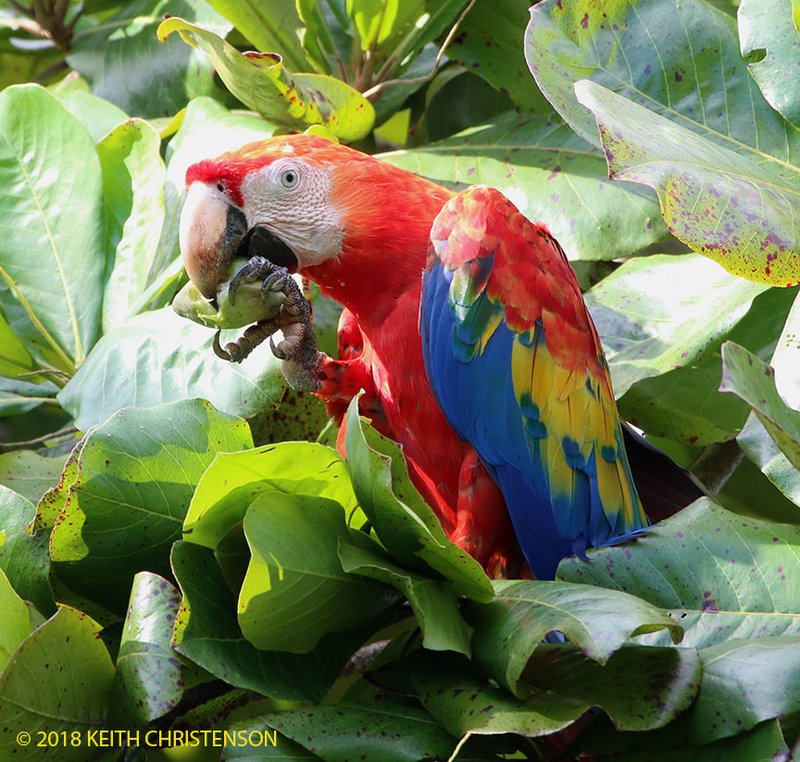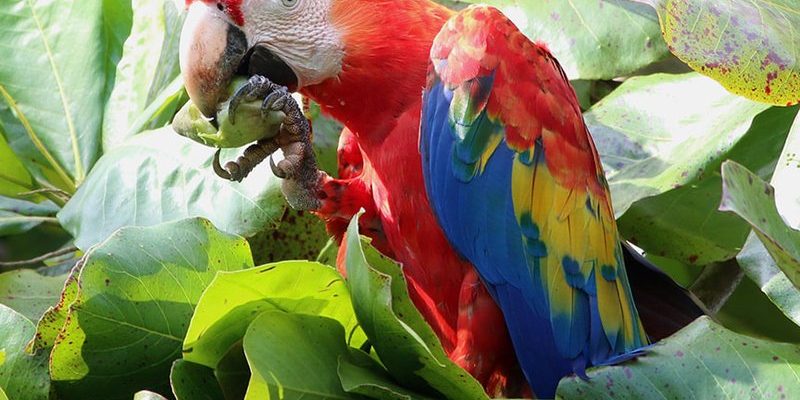
Scarlet Macaws primarily thrive in the lush, tropical rainforests of Central and South America. You might think they simply munch on whatever they find, but their feeding strategy is much more sophisticated. They have a diverse diet and unique foraging skills that highlight their role in the ecosystem. Understanding what they eat can give us insights not just into their behavior, but also into the health of their habitat. So grab a cup of your favorite brew, and let’s explore what makes this beautiful creature tick!
The Scarlet Macaw’s Diet: A Colorful Menu
Scarlet Macaws are primarily herbivorous, which means they enjoy a plant-based diet. If you’re picturing these birds as picky eaters, think again! They have a taste for a wide variety of foods, which helps them adapt to different environments. Here’s what’s usually on their menu:
- Fruits: One of their favorites! They love juicy fruits like mangoes, papayas, and various berries. These treats not only satisfy their hunger but also provide essential vitamins and minerals.
- Seeds: Macaws are big fans of seeds. They often feed on seeds from trees, nuts, and even palm fruits. Their strong beaks are perfect for cracking open hard shells to get to the nutritious seeds inside.
- Flowers: It might surprise you, but these birds also munch on flowers. They enjoy both the nectar and the petals, which offer hydration and additional nutrients.
This varied diet makes Scarlet Macaws crucial for the environment. By eating fruits and seeds, they help disperse seeds through their droppings, promoting plant growth. This is beneficial for the ecosystem, creating a healthier habitat for other wildlife.
How Scarlet Macaws Forage for Food
Foraging is more than just grabbing a snack; it’s an art form for Scarlet Macaws. They use a combination of sight, memory, and social cues to locate food. Here’s how they do it:
- Visual Cues: Scarlet Macaws have excellent eyesight. They can spot ripe fruits from a great distance, which allows them to move quickly from tree to tree. Imagine having superhero vision for spotting a ripe mango!
- Social Learning: These birds are social creatures. Young macaws often watch their parents and other flock members to learn which foods are safe and tasty. It’s like learning to cook by watching a master chef.
- Memory: Macaws have strong memories. If they find a fruiting tree once, they’ll likely remember to return later. This ability is crucial, especially when food becomes scarce.
By foraging effectively, Scarlet Macaws can thrive in their environment, adapting to seasonal changes and food availability.
The Tools of the Trade: Adaptations for Feeding
Scarlet Macaws come equipped with several adaptations that aid in their foraging efforts. Their physical traits are fascinating and serve specific purposes:
- Strong Beak: Their beak is not just for show. It’s incredibly powerful and curved, perfect for cracking open hard nuts and seeds. Think of it as a multi-tool that helps them access a variety of foods.
- Long Tongue: They have a long, pointed tongue that helps them extract seeds from fruits and flowers. This unique tool allows them to enjoy the nectar hidden deep inside blooms.
- Prehensile Toes: Macaws have zygodactyl feet, meaning they have two toes pointing forward and two backward. This grip helps them hold onto branches securely while they search for food.
These adaptations not only make them effective foragers but also contribute to their survival in the wild.
Seasonal Changes and Food Availability
Like many animals, Scarlet Macaws face seasonal fluctuations in food availability. During certain times of the year, their preferred foods may become less abundant. Understanding these changes is vital for their survival.
During the dry season, for instance, fruits can be hard to come by. In response, Scarlet Macaws may change their diet by focusing on more robust seeds and nuts. They’ve been known to travel great distances in search of food, showcasing their adaptability.
Here’s what happens when food is scarce:
- Exploration: During tough times, macaws might venture into new territories. This exploration helps them discover new food sources, which can be crucial for their survival.
- Flocking Behavior: They often forage in groups, which increases their chances of finding food. Think of it as a community potluck where everyone brings something to the table!
By adapting their foraging strategies, Scarlet Macaws ensure they can thrive even when times get tough.
The Role of Habitat in Foraging
Scarlet Macaws are native to the rainforests of Central and South America, where their foraging techniques are closely linked to their habitat. The richness of their environment plays a significant role in their diet and overall survival.
- Diverse Ecosystems: The rainforest provides a wide variety of fruits, seeds, and flower species. This diversity is essential for the macaw’s diet, allowing them to thrive year-round.
- Tree Height: The tall trees of the rainforest are perfect for macaws. They can find food high in the canopy while also staying safe from potential predators.
However, as deforestation and habitat destruction increase, these birds face challenges in finding adequate food sources. This highlights the need for conservation efforts to protect their natural habitat.
Conservation Efforts and Eating Habits
Speaking of conservation, it’s important to recognize the link between the Scarlet Macaw’s eating habits and the health of their ecosystems. When their habitat is threatened, so is their diet. Deforestation impacts the availability of food sources, directly affecting their survival.
Here’s how conservation efforts can make a difference:
- Reforestation: Planting trees helps restore habitats for these birds, ensuring they have access to the foods they need. You might think of it as planting a grocery store just for them.
- Education: Raising awareness about the importance of Scarlet Macaws and their role in the ecosystem can help encourage protective measures. The more people know, the more they can help!
In the end, a healthy Scarlet Macaw population reflects a thriving rainforest ecosystem.
The Scarlet Macaw’s diet and foraging habits reveal much about its role in the environment. From their colorful meals of fruits and seeds to their impressive foraging skills, these beautiful birds are not just feast lovers—they are essential players in their ecosystems.
Understanding what they eat and how they find their food emphasizes the importance of protecting their habitats. As we enjoy the beauty of these birds, it’s crucial to remember how interconnected we all are with our environment. By supporting conservation efforts, we can help ensure that future generations will also admire and learn from the vibrant Scarlet Macaw.

